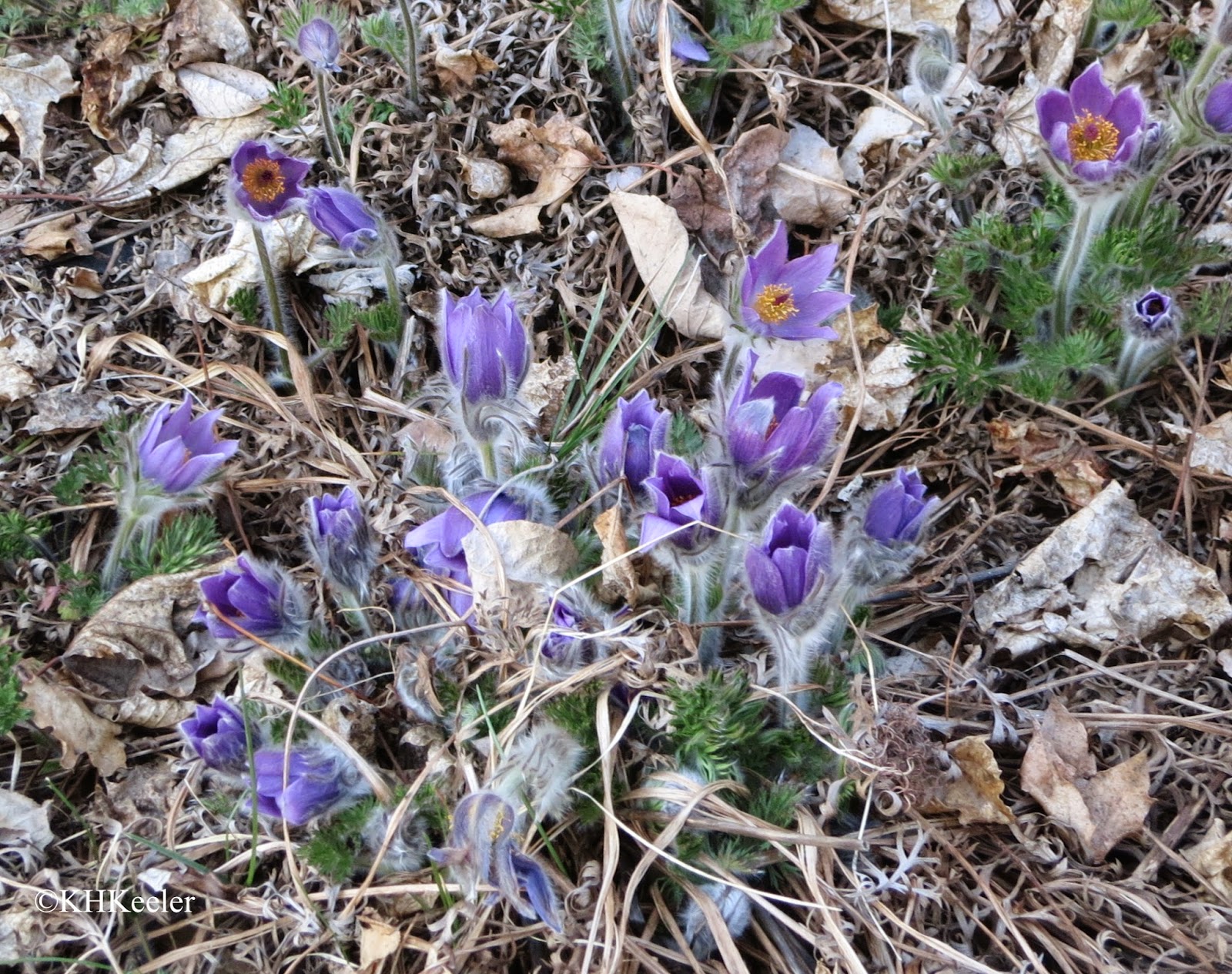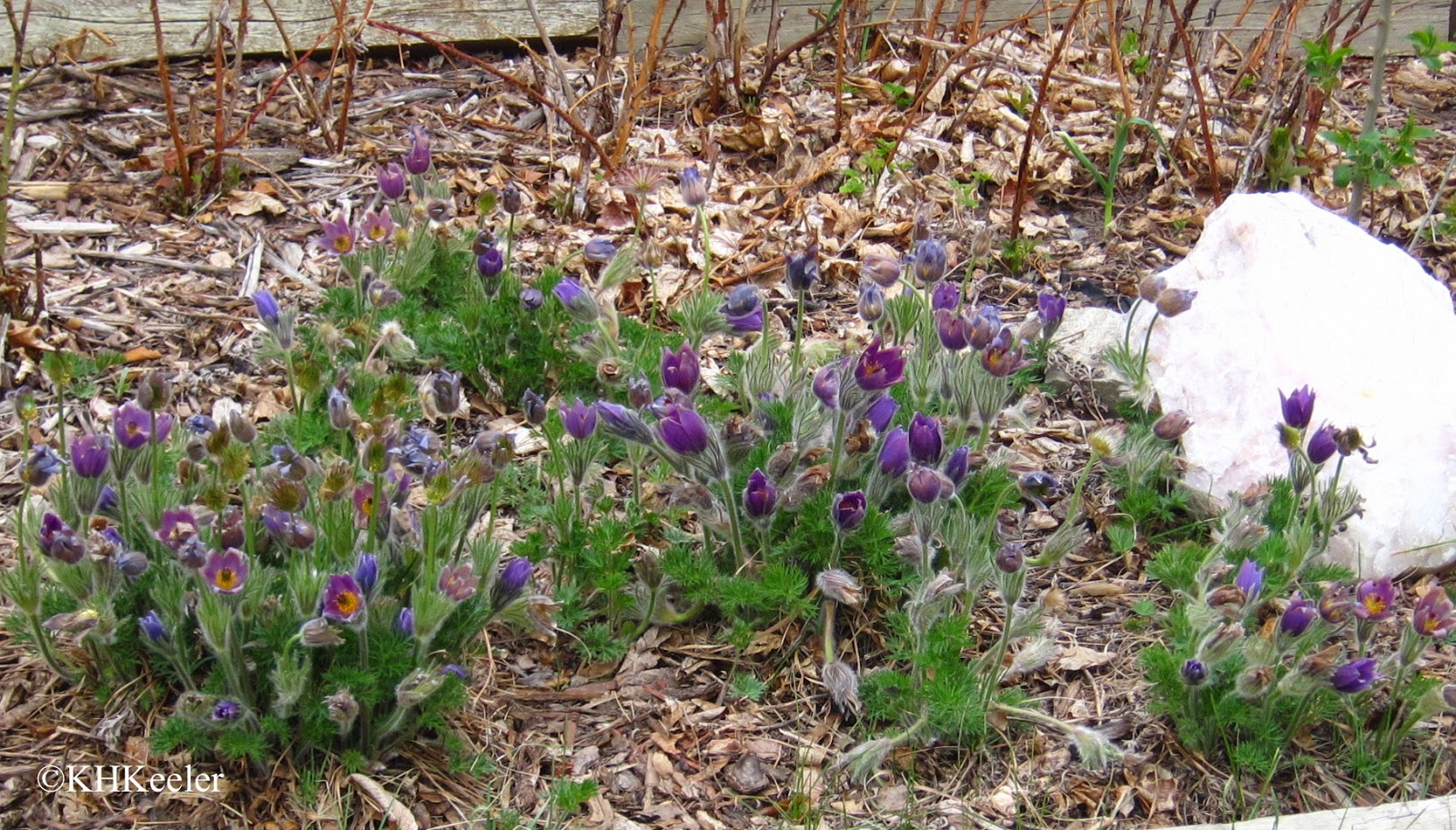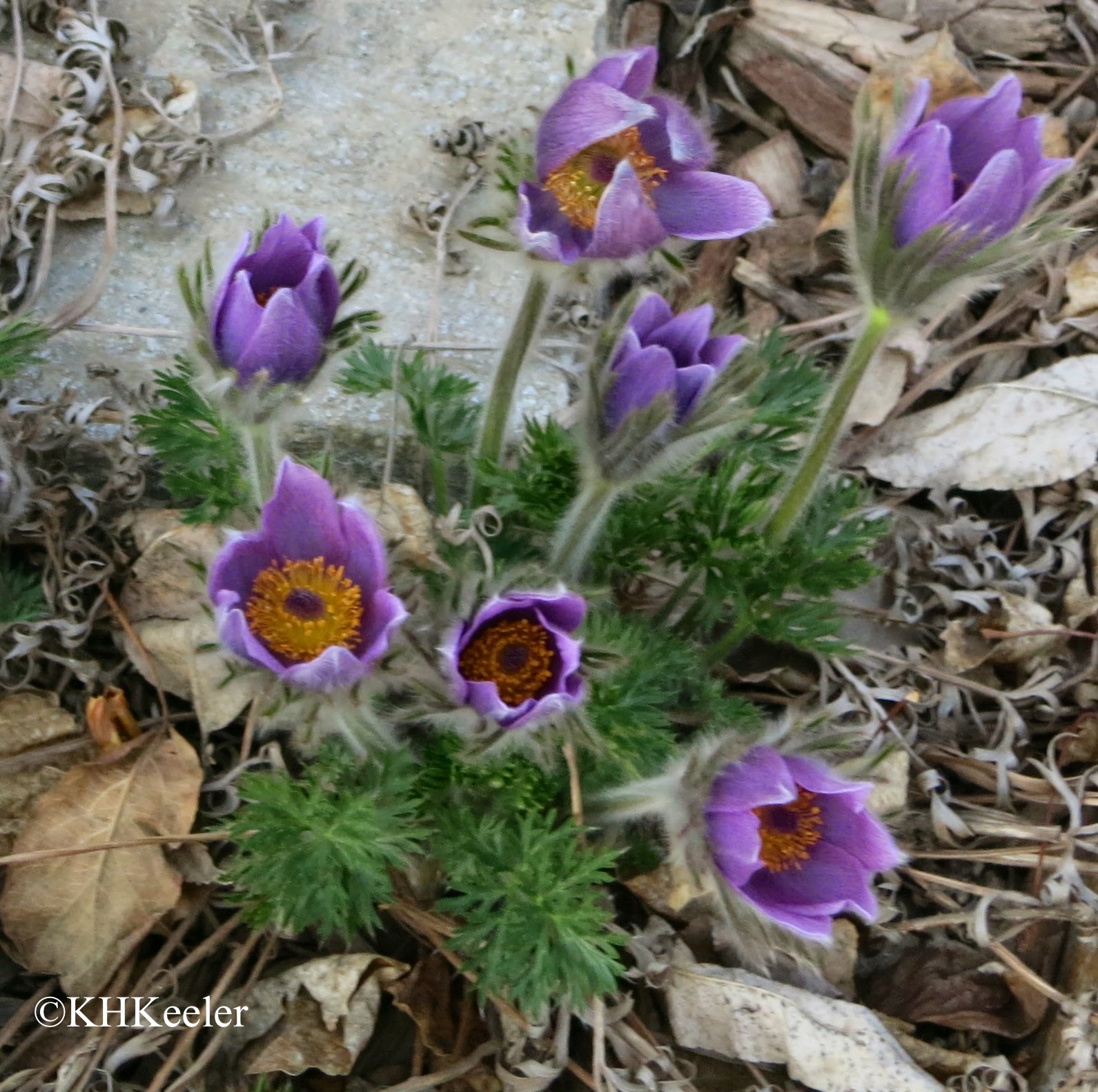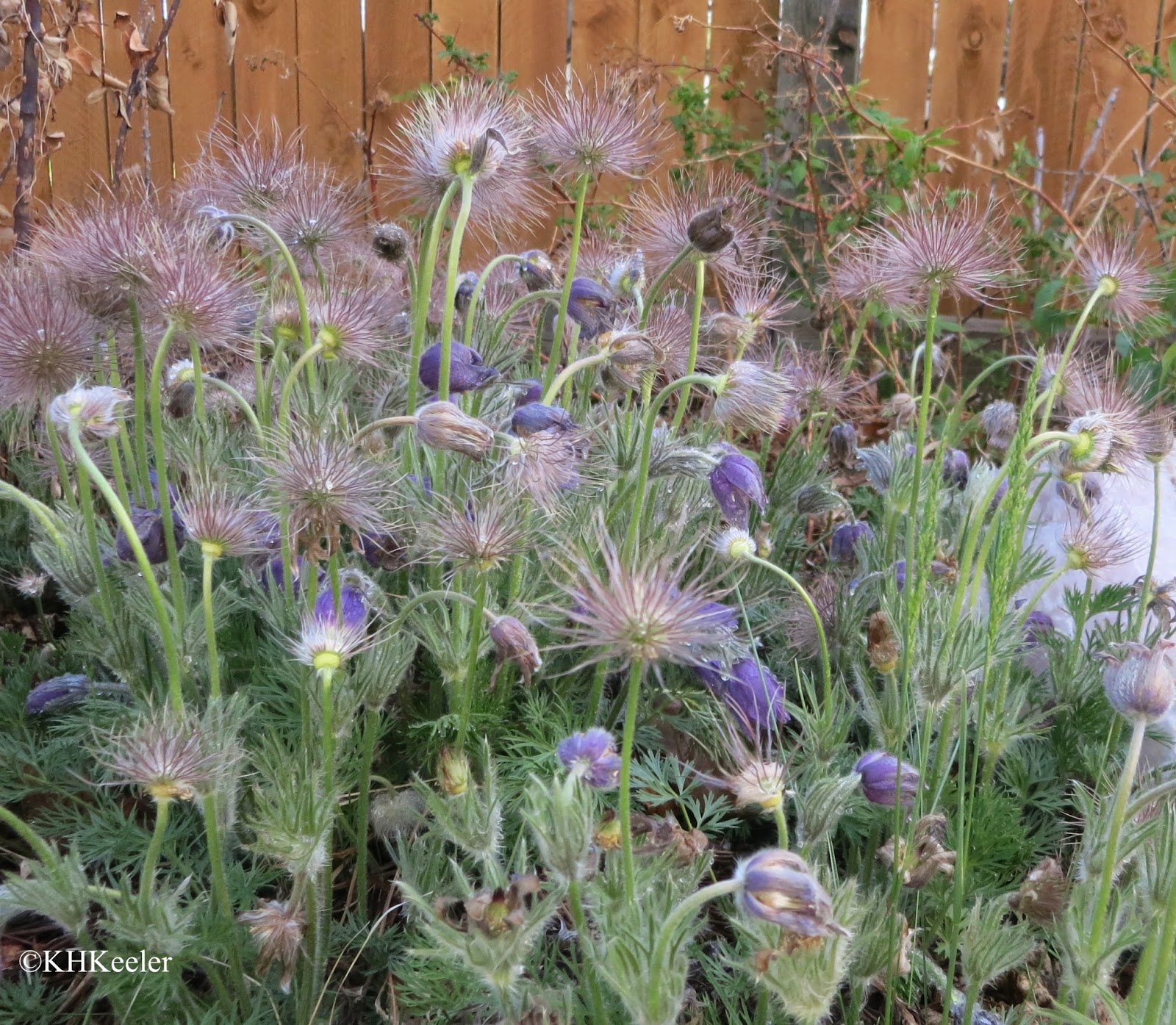When I tell people pasqueflower is the first wildflower of spring, they look at me doubtfully because crocuses and daffoldils are in full bloom. But across most of its range, there are no native herbs that flower earlier in the spring than pasqueflower.
Pasqueflower is an anemone, Anemone patens. The name refers to its blooming time, from the Old French for Easter. In some places it is called May Day flower--same idea!
"May Day!" you exclaim, "spring is well under way by then." For you, maybe. But pasqueflower is the state flower of South Dakota, USDA Zone 3 to 5, where the last killing frost is often late in May, and the provincial flower of Manitoba, which has an even shorter growing season.
Although it isn't native east of Michigan and Illinois (link to USDA map), Anemone patens is called the eastern pasqueflower because the one other pasqueflower in North America is found on the Pacific Coast. (white pasqueflower range: Link)
If you followed the link to the USDA maps, you will have noticed that they call eastern pasqueflower Pulsatilla patens, not Anemone patens. Right now the correct name has not been agreed upon by the botanical community.
(Explanation if you want it: Pasqueflowers are clearly special anemones. They are found all over the world - For example, Pulsatilla/Anemone chinensis is an important Chinese medicinal herb (bái tóu wēng, translated "hoary-headed geezer," a name that reflects the distinctive seed heads of pasqueflowers).
 |
| Pasqueflower seed heads, Canadian Rockies |
Except, as I explained in post on plants with two scientific names, link, publishing a change doesn't mean other botanists see it the same way. When a revision is published, the botanical community considers it and if they are convinced, apply the changed names, and if not, they ignore the changes. So, assuming the USDA plants website was recently updated, the USDA's experts don't agree.
Where does that leave us users of scientific names? In limbo. The easy approach is to pick an expert (current reference) and use whatever name they use. Or you can go with your personal opinion. I'll follow the Flora of North America's decisions so I'm using Anemone..link
One practical consequence of this situation: When searching the web or an index for pasqueflowers, try both Anemone and Pulsatilla.)
By either scientific name, pasqueflower is in the buttercup family, Ranunculaceae. Buttercups are characteristically early spring wildflowers, found in cool north temperate regions (northern Europe, Siberia, northern North America) and toxic or at least not edible. All of those fit anemones including the pasqueflowers as well as buttercups generally.
The foliage can irritate the skin, sometimes to the point of blisters. The Blackfeet used a poultice as a counter irritant and the Omaha applied the leaves as a treatment of rheumatism. Blackfeet also enjoyed the practical joke of handing someone pasqueflower leaves as toilet paper. An old common name for pasqueflower is hartshorn plant. Ground hart (red deer)'s horn releases ammonia and was used to revive people who had fainted by irritating nose and lungs. The volatile chemicals from pasqueflower leaves have the same effect.
The Dakota Sioux thought every species had its own song. Because it is the first native wildflower in bloom, the pasqueflower's song calls the other plants from the ground. Here is a Dakota song of the pasqueflower (Twin-flower is a translation of their name for pasqueflower):
"The Song of the Twin-Flower
I wish to encourage the children
Of other flower nations now appearing
All over the face of the earth;
So while they awake from sleeping
And come up from the heart of the earth
I am standing here old and gray-headed.
When an old Dakota first finds one of these flowers in the springtime, it reminds him of his childhood, when he wandered over the prairie hills at play, as free from care and sorrow as the flowers and the birds. He sits down near the flower on the lap of Mother Earth, takes out his pipe and fills it with tobacco. Then he reverently holds the pipe toward the earth, then toward the sky then toward the north, the east, the south and the west. After this act of silent invocation he smokes. While he smokes he meditates upon all the changing scenes of his lifetime, his joys and sorrows, his hopes, his accomplishments, his disappointments and the guidance which unseen powers have given him in bringing him thus far on the way and he is encouraged that he will be guided to the end. After finishing his pipe he rises and plucks the flower and carries it home to show his grandchildren, singing as he goes The Song of the Twin-Flower, which he learned as a child and which he now in turn teaches his grandchildren. "
(song translated by A. McG. Beede, that and quote from Gilmore pp 80-82 link.)
It is difficult to find what I call Native American plant folklore--stories about plants that are unrelated to their practical uses. This quote approaches that, giving us the Dakota tradition that recognizes the pasqueflower as leading the plants, both into flower and into seed. If you see pasqueflowers this year, I hope you will stop for a moment to review your life and your blessings and to share the story with those with you.
Comments and corrections welcome.
References:
Farrrar, J. 1990. Field Guide to the Wildflowers of Nebraska and the Great Plains. Nebraska Game and Parks Commisssion, Lincoln NE print.
Gilmore, M. R. 1919. Uses of Plants by the Indians of the Missouri River region. University of Nebraska Press, Lincoln NE. online
Kindscher, K. 1992. Medicinal Wild Plants of the Prairie. University of Kansas Press, Lawrence, KS. print
Moerman, D.E. 1998. Native American Ethnobotany. Timber Press, Portland OR. print.
Pulsatilla vulgaris http://www.missouribotanicalgarden.org/PlantFinder/PlantFinderDetails.aspx?kempercode=b350. Accessed 4/5/15 About the European pasqueflower
Kathy Keeler
More at awanderingbotanist.com
Join me on Facebook: https://www.facebook.com/AWanderingBotanist
Buy the book! Curious Stories of Familiar Garden Plants by Kathy Keeler, A Wandering Botanist
This story and more. Now available on Amazon link
Buy the book! Curious Stories of Familiar Garden Plants by Kathy Keeler, A Wandering Botanist
This story and more. Now available on Amazon link






No comments:
Post a Comment